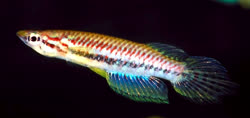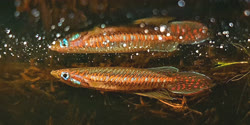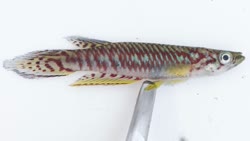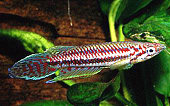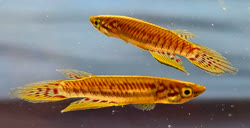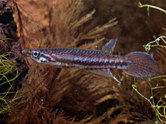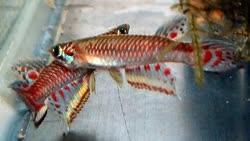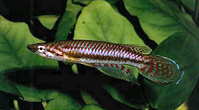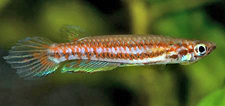|
|
Notes on this unusual viviparous species can be found below.
"There is a well documented report by Gauma of VIVIPARITY in this species(1982; Hydrobiologia 89: 285-300; "On the biology of female Epiplatys bifasciatus (Cyprinodontidae) from southern Sudan"). Gauma's specimens were from the Bahr el Ghazel. Incredibly, despite the general interest in the evolution of viviparity, NO ONE has followed this up even to the extent of just looking at specimens from other drainages." Bruce Turner, June 2022, FB
From Gauma's papar: History "Extensive work has been carried out on different species on the genus Epiplatys. Beyer (1931 b), Innes (1935b), Stoye (1935b), Loiselle (1970), Schwartz (1971) and Corbet et al. (1973) studied the general biology of E. sexfasciatus (Gill). Breeding habits of different species were investigated by Mller (1926a, b), Baake (1930a), Rasmussen (1948), Seidal (1969) and Roloff (1970), while spawning behaviour was documented by Kammerzell (1926b), Mitch (1937a) and Mayer (1954b). Biogeography and systematics were extensively studied by Jahns (1968), Scheel (1968), Goldstein (1969), Lambert (1969), Neumann (1969), Bech (1971) and Seidel (1971). A comprehensive review of the literature up to 1966 is given by Sterba (1962) and Breder & Rosen (1966). Reproduction "The morphology of female E. bifasciatus does not change during the breeding season and despite being categorized as an oviparous fish (Sterba 1962), E. bifasciatus does not strictly follow that category. Fertilization is internal, and partial (i.e. not all the oocytes are fertilized at the same time). Studies on absolute fecundity revealed that only a small number of embryos (15 to 35) develop at any one time. The destined embryos are moved to the 'nursing' portion of the ovary where they continue their development (Fig. 3) until their gill-clefts are formed, although the eye pigment is not laid, and the jaws are not completely separated until the embryo is outside the mother. Yolk reserves are retained by the embryos until hatching, which takes place outside the mother. The broods are shed at intervals, but details of this have not been followed in this study." Food "Sandon (1950) and Loiselle (1969) noted that E. bifasciatus fed mainly on mosquito larvae. This however was not the case in this study, where the most dominant items in the food were chironomid larvae. Mosquito larvae were observed to be taken only by the larger fish (> 26 mm) and did not comprise more than 30% of the food (Fig. 4b). This would suggest an inclination towards bottomfeeding habits. However, as a whole, the presence of adult insects and aquatic spiders in the food equally suggests surface feeding. Twenty-four different food organisms were recorded in the food of Epiplatys, 64% of which belonged to the class Insecta, 16% to the Crustacea, 4% to the Arachnida, and 8% aquatic macrophytes. This wide range of food organisms suggests different ways of feeding and excellent adaptation to the environment."
|
